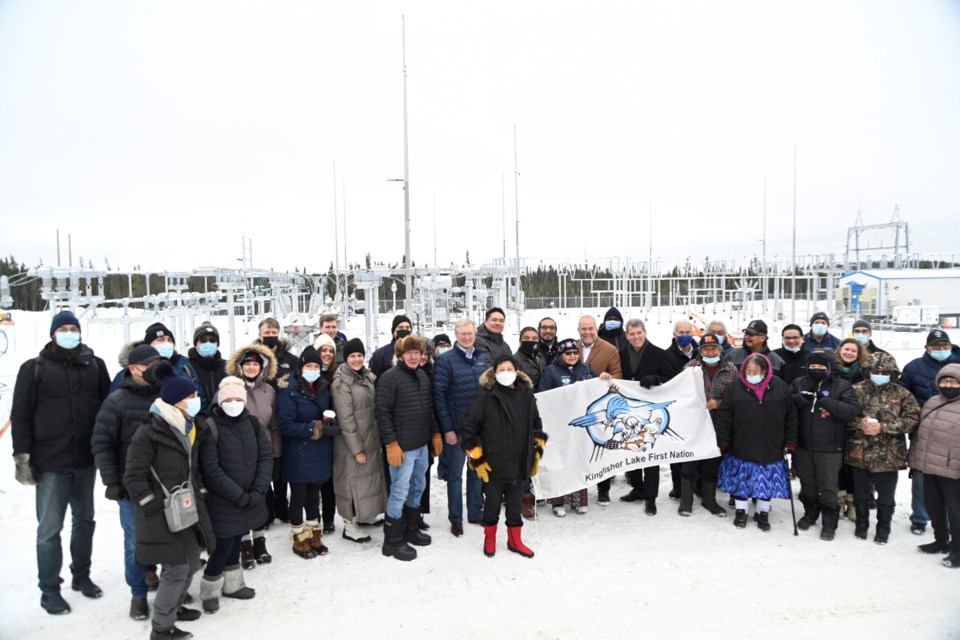KINGFISHER FIRST NATION - With the connection of Kingfisher First Nations to the provincial power grind on Nov. 23, Wataynikanyap Power continues to position 17 remote First Nations communities into what it calls a more equitable socio-economic future.
So far, the Wataynikaneyap project has created 500 to 1,300 jobs during construction, and is expected to contribute nearly $900 million in socio-economic benefits, such as lowering greenhouse gas emissions and generating new competitive marketplaces across Northwestern Ontario.
Of the 17 communities that will be energized by the provincial power grid, Kingfisher First Nation joins Pikangikum First Nation and North Caribou Lake First Nation in having so far been freed from their dependence on diesel-generated electricity.
The move is expected to save the Government of Canada and Ontario energy consumers millions of dollars annually.
However, the largest benefits will come in the form of reliable energy for the rural and remote First Nations, which leaders say will bring major improvements in quality of life.
“We had an Elder that spoke who really alluded to a lot of benefits in terms of the health and safety aspect of the community. The food, the housing, health services, and other improvements will enhance those services that are currently in place,” said Margaret Kenequanash, CEO of Wataynikaneyap Power, which is 100 per cent Indigenous-owned among the 24 First Nations in northwestern Ontario.
Kenequanash said while these First Nation communities are expanding, available power is not. Many communities still running diesel generators are at capacity, she said, causing rolling blackouts which compromise important infrastructures like nursing stations, water and sewer treatment plants, and food management facilities.
“We have people who have chronic conditions. Some people who are in palliative care may have to be brought into urban hospital settings, away from their family members, because there is just no availability in the nursing stations,” said Kenequanash.
Another important issue these communities are experiencing is a lack of power to maintain buildings such as schools and housing.
Many First Nations schools are forced to close due to the health code. Rolling blackouts affect boiler systems, air filtration units, and waste management systems.
“A lot of schools have been closed because of the number of outages that have taken place,” said Kenequanash.
With an expanding population, new housing developments are also sometimes being erected without power.
“One time I went to [Kitchenuhmaykoosib Inninuwug] and they had five new housing units standing there. They weren’t able to connect them. So, a lot of time communities will swap the older home’s power to the new house, but that doesn’t address the housing shortage within the community,” explains Kenequanash.
The Wataynikanyap Power Transmission Project marks a transition to the future as they prepare to join the provincial power grid. Kenequanash said the project represents a vision of reliability, with 24 First Nations joined together as stakeholders to bring an equitable future for generations to come.
“I always tell people there is a vision in this; In how we are going to create an equity position for our First Nations so that they have the same level [playing field] as everyone else, and competing in commercial business and anything that they want to do in their homelands,” said Kenequansh.
Speaking of the future, Kenequanash said “there is still quite a bit of work to do,” but if construction stays on schedule, communities including Wunnumin Lake, Muskrat Dam, Bearskin Lake, Wawkapewin, and Kasabonika Lake will be connected to the provincial grid as soon as spring/summer of 2023.
“Clearing is at 91 per cent for all areas. I think some areas require a little bit more,” said Kenequanash.
She also reported structural foundations are 72 per cent complete, with 3,048 out of 4,230 constructed. Tower assembly is 79 per cent complete, while line stringing is 51 per cent complete.
“Watay has reached a significant milestone for this project once again, and this has taken so many years to bring into fruition,” said Kenequanash.
